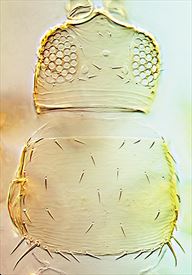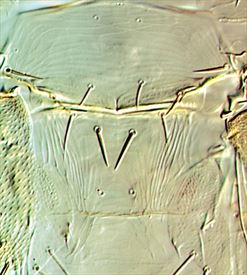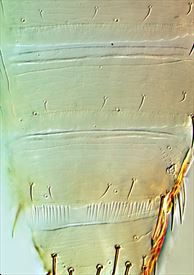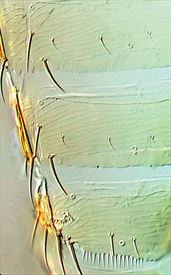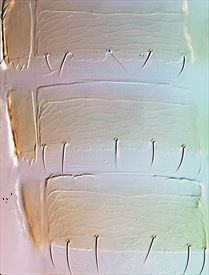Distinguishing features
Female fully winged or micropterous. Colour mainly yellow; major setae dark; fore wings pale grey; antennal segments II–VII brown but II and pedicels of III–V paler than distal segments. Antennae 7-segmented; segments III and IV each with sense cone forked; III–VI with microtrichia on lines of sculpture; VI with an elongate sense cone. Head broad, with 3 pairs of ocellar setae; ocellar setae I small, weak; ocellar setae III arising between posterior ocelli; postocular setae uniseriate. Mouth cone extending between fore coxae; maxillary palps 3-segmented. Fore wing 1st vein with 3 widely spaced setae on distal half, 2nd vein with 6 or 7 setae, these widely spaced distally. Pronotum weakly sculptured; setae relatively stout; posterior margin with 4 pairs of setae; 2 pairs of major posteroangular setae, external pair shorter than internal; prosternal ferna undivided. Mesonotum and metanotum with lines of sculpture apparently raised into weak flanges. Mesonotal median setae arising less than their own length from posterior margin. Metanotal median setae not at anterior margin; spinula not developed. Tarsi 2-segmented. Tergal median setae small; tergites faintly but completely sculptured; II–VII with a broad posteromarginal craspedum; VIII with posteromarginal comb of long microtrichia interrupted medially by a small craspedum, paired ctenidia anterolateral to spiracles (none on preceding tergites); tergite X with dorsal split incomplete. Pleurotergites clearly differentiated with a broad craspedum but no discal setae. Sternites without discal setae; II with 3 pairs of minute anterior setae and 2 pairs of posteromarginal setae; II–VI with a narrow, lobed craspedum between posteromarginal setae; III–VII with 3 pairs of posteromarginal setae, S1 and S2 on VII arising submarginally. Micropterous female with small fore wing rudiment.
Male not known.
Related species
Two species are recognised in the genus Lomatothrips, the second one L. pinopsidis Mound being from Podocarpus and Callitris in Australia (Mound, 2006). The structure of the posteromarginal comb on tergite VIII of L. paryphis is particularly unusual among Thripidae.
Biological data
A few adults of this thrips were colllected originally from Carpodetus serratus [Grossulariaceae] and others from leaf litter, but subsequently it was reared from Podocarpus totara (Martin & Mound, 2004) and also from Prumnopitys taxifolia.
Distribution data
Known only from New Zealand, where it has been collected at Tennyson inlet (South island), also from RI, H/SD, BR and CO.
Family name
THRIPIDAE, THRIPINAE
Species name
Lomatothrips paryphis Mound & Walker
Original name and synonyms
Lomatothrips paryphis Mound & Walker, 1982: 67
References
Martin NA & Mound LA (2004) Host plants for some New Zealand thrips (Thysanoptera: Terebrantia). New Zealand Entomologist 27: 119–123.
Mound LA. 2006. Vicariance or dispersal – trans-Tasman faunal relationships among Thysanoptera (Insecta), with a second species of Lomatothrips from Podocarpus. Papers and Proceedings of the Royal Society of Tasmania 140: 11-15.
Mound LA & Walker AK (1982) Terebrantia (Insecta: Thysanoptera). Fauna of New Zealand 1: 1–113.

